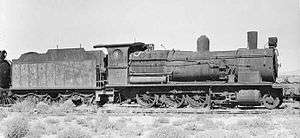Commonwealth Railways KA class
|
A KA class locomotive, c 1951. | |||||||||||||
| |||||||||||||
| |||||||||||||
| |||||||||||||
| |||||||||||||
The Commonwealth Railways KA class was a class of 2-8-0 tender locomotives of the Commonwealth Railways, Australia. The class operated on the 1,435 mm (4 ft 8 1⁄2 in) Trans-Australian Railway.
History
Between September 1918 and June 1920, Commonwealth Railways took delivery of 26 KA class freight locomotives built to the same design as the New South Wales Government Railways' TF class (later the D53 class). Six were built by Perry Engineering, Gawler and 20 by Walkers Limited, Maryborough.[1][2] They were an upgraded version of the K class.
The Perry built locomotives received superheaters in 1943. Three were converted to burn oil during the 1949 coal strike, but were converted back within months.[1]
Most survived until replaced by GM class diesel locomotives with the last withdrawn in September 1952.[1]
References
Notes
Bibliography
- Fluck, Ronald E; Marshall, Barry; Wilson, John (1996). Locomotives and Railcars of the Commonwealth Railways. Welland, SA: Gresley Publishing. ISBN 1876216018.
External links
![]() Media related to Commonwealth Railways KA class locomotives at Wikimedia Commons
Media related to Commonwealth Railways KA class locomotives at Wikimedia Commons
